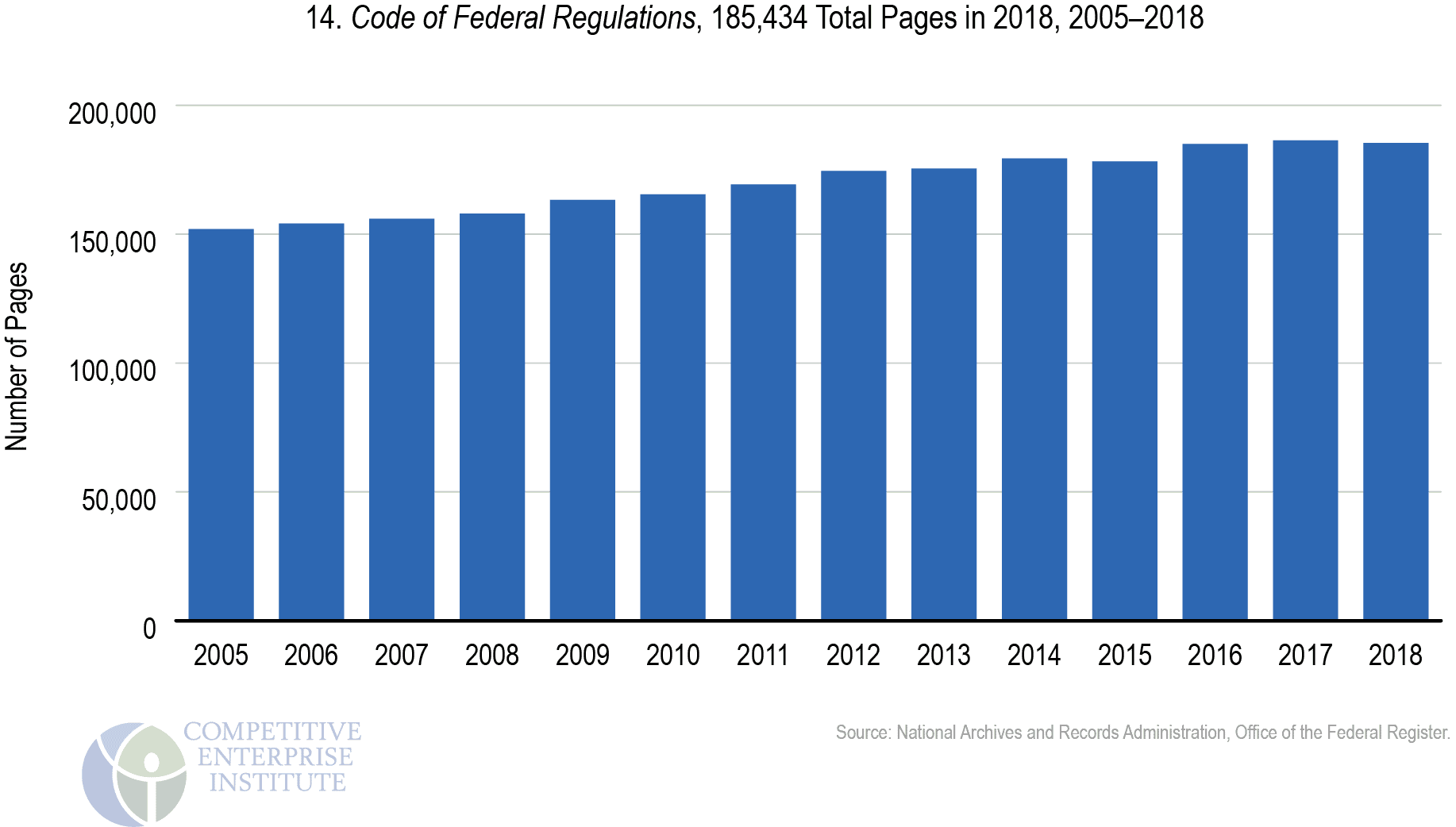Thousands of Pages in the Federal Register
Ten Thousand Commandments 2019 - Chapter 5
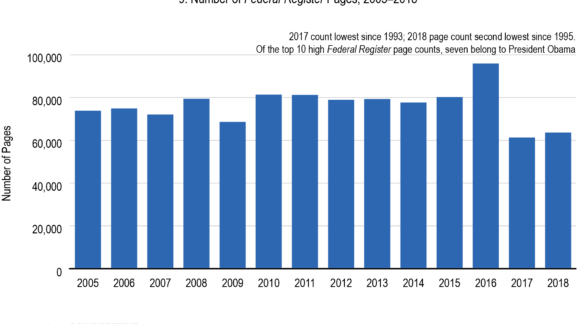
Download Chapter 5 as a PDF
The Federal Register is the daily repository of all proposed and final federal rules and regulations.[i] Although its number of pages is often cited as a measure of regulation’s scope, there are grave problems with relying on page counts. A short rule may be costly and a lengthy one may be relatively cheap. The Federal Register also contains many administrative notices, corrections, rules relating to the governance of federal programs and budgets, presidential statements, and other material. They all contribute bulk and bear some relation to the flow of regulation, but they are not strictly regulations. Blank pages also affect page counts. In previous decades, blank pages numbered into the thousands owing to the Government Publishing Office’s imperfect estimation of the number of pages that agencies would require. In terms of Trump’s one-in, two-out agenda, one cannot easily look at the Federal Register and get a sense of what rules are being cut. Moreover, a rule that some see as deregulatory, others may see as regulatory.
Shortcomings notwithstanding, it is worthwhile to track the Federal Register’s page counts and related tallies as an indicator of regulatory activity. It is probable that the shutdown of December 22, 2018, through January 25, 2019, will have had some effect on the deregulatory efforts to be unveiled in 2019, since it affected some of those carrying out the directives.[ii] It also delayed production of the National Archives official archival roundup of pages and numbers of rules, although preliminary data are available.
Federal Register Pages—Up 4 percent between Trump Years One and Two
The first calendar year of the Trump administration finished with 61,308 pages in the Federal Register (see Figure 9). The last time annual page count had been that low was a quarter-century ago in 1993, at 61,166 pages under Bill Clinton.
The 2017 count contains three weeks of Obama administration output, however, and by the time Trump was inaugurated on January 20, 2017, the Obama administration had already added 7,630 pages to the Federal Register, making Trump’s “net” page count 53,678.[i] In 2018, the Federal Register reached 63,645 pages, a 4 percent increase over Trump’s first year.[ii]
By contrast with both of these, at the end of Obama’s final calendar year of 2016, the number of Federal Register pages stood at 95,854, which was the highest level in the history of the Federal Register, and a 19 percent jump over Obama’s second-to-last year’s count. Trump’s 2017 count was 36 percent below Obama’s record. The last time a drop in Federal Register page counts of the Trump magnitude happened was when Ronald Reagan reduced the count from Jimmy Carter’s 73,258 in 1980 to 44,812 by 1986, but that 28,446-page drop took five years.[iii]
Trump’s recent 2018 count of 63,645 is still 34 percent below Obama’s record. The last time the page count was lower was back in 1995. Keep in mind that to eliminate a rule, agencies have to write a rule. So in a perverse sense, Trump cannot shrink the Federal Register (nor the number of rules), yet is still doing so. As Figure 9 also captures, 2010 and 2011 had been the prior all-time record years, at 81,405 and 81,247, respectively. Of the 10 all-time high Federal Register page counts, seven occurred during the Obama administration. (For a history of Federal Register page totals since 1936, see Appendix: Historical Tables, Part A.)
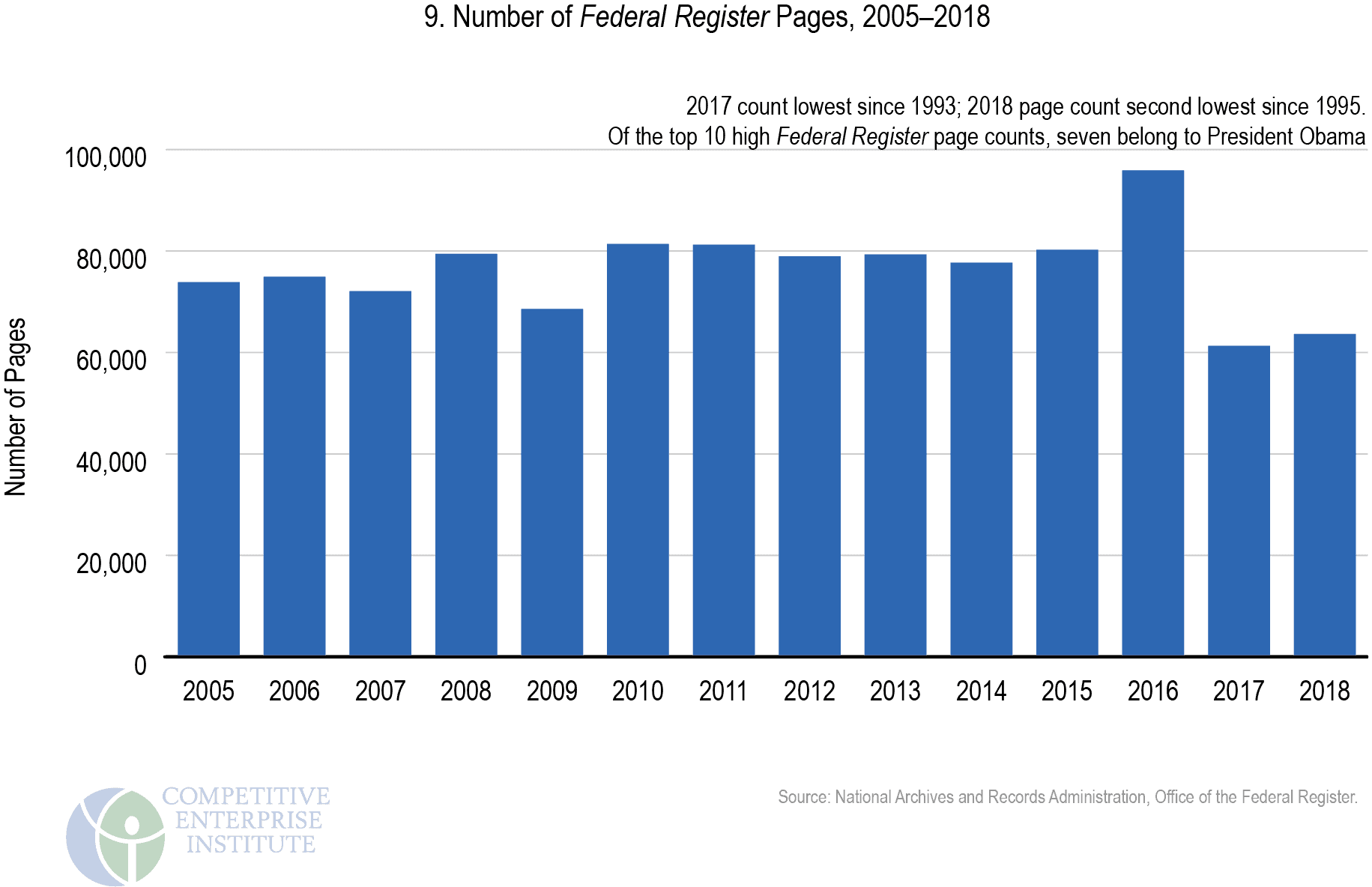
Federal Register Pages Devoted to Final Rules
Isolating the pages devoted to final rules might be more informative than gross page counts, because it omits pages devoted to proposed rules, agency notices, corrections, and presidential documents (although those categories can have regulatory effects, too).
Final rule page count of 2018 stands at 16,378, the lowest count since 1992. Nonetheless, two things stand out in Figure 10: (a) the jump from 2015 to 2016 under Obama, when the number of pages devoted to final rules jumped by 56 percent, from 24,694 to 38,652 and (b) the drop of 51 percent from there to 18,727 pages of rules under Trump in 2017. Obama’s high was a record that shattered 2013’s then-peak of 26,417 by 46.3 percent. Trump’s 2017 count, by contrast, was the lowest seen since 1995.
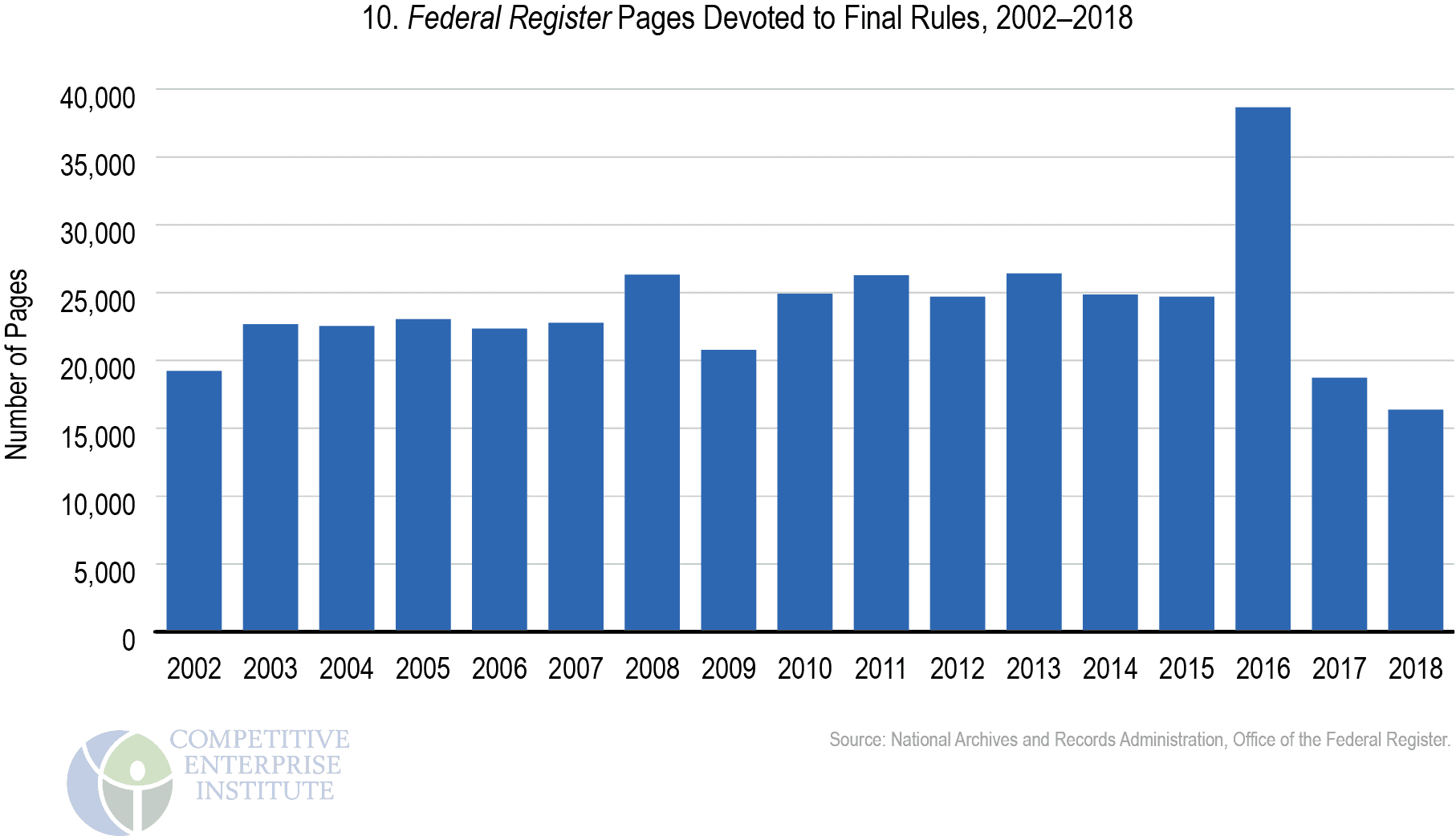
While more relevant measures than pages include underlying restrictions and actual burdens, for page counts to drop so steeply between administrations is significant. Relevant to the discussion about controlling future regulatory costs are pages of proposed rules, those under production in the regulatory pipeline. These peaked at 23,193 in 2011, and Obama’s final page count of proposed rules was 21,457 in 2016. Under Trump, Federal Register pages devoted to proposed rules in 2017 were 10,892, half the level of Obama’s concluding years, and the lowest since 1981. These rose to 16,207 in 2018, however.
Still another way of looking at Federal Register trends is by pages per decade (see Figure 11). Even with Trump’s cut so late in the 2010s, we still will get a jump over the prior decade. The last bar of Figure 11 projects the average of the past nine years of 77,746 pages for the decade as a whole (the projection at the moment is 777,464). Even with the page count reduction during Trump’s administration, decade page counts could easily top 1 million in the 2020s, as a glance at increases since the 1940s makes clear.

Number of Final and Proposed Rules in the Federal Register
In 2018, Trump has done better than Obama, Bush II, and Clinton in terms of issuing fewer final regulations, but not as good as his own first year. In 2016, the final full year of the Obama administration, the number of final rules published in the Federal Register reached 3,853, the highest total of the Obama administration and the highest level since 2005. Under Trump, final rules dipped to 3,281 in 2017 (see Figure 12). This was the lowest count since records began being kept in the mid-1970s. In 2018, the rule count bumped up to 3,368, the second lowest count.[i]
The number of final rules currently being published is lower than it was throughout the 1990s, when the average annual total of final regulations was 4,596. The average for the period 2000–2009 was 3,948. Even Obama’s highest count was below those levels, and Obama’s lowest count of 3,410 was not much above Trump’s new score. Of course, not all rules are created equal, and fewer of Obama’s rules would be expected to have been devoted to rollbacks of prior initiatives, the emphasis of Trump’s one-in, two-out directive. Additionally, 207 rules issued in 2017 up to the point of Trump’s inauguration on January 20 were Obama’s, giving Trump a “net” of 3,074 that year.[ii] Note again that deregulatory actions by Trump that require notice-and-comment will add to his final and proposed rule counts.
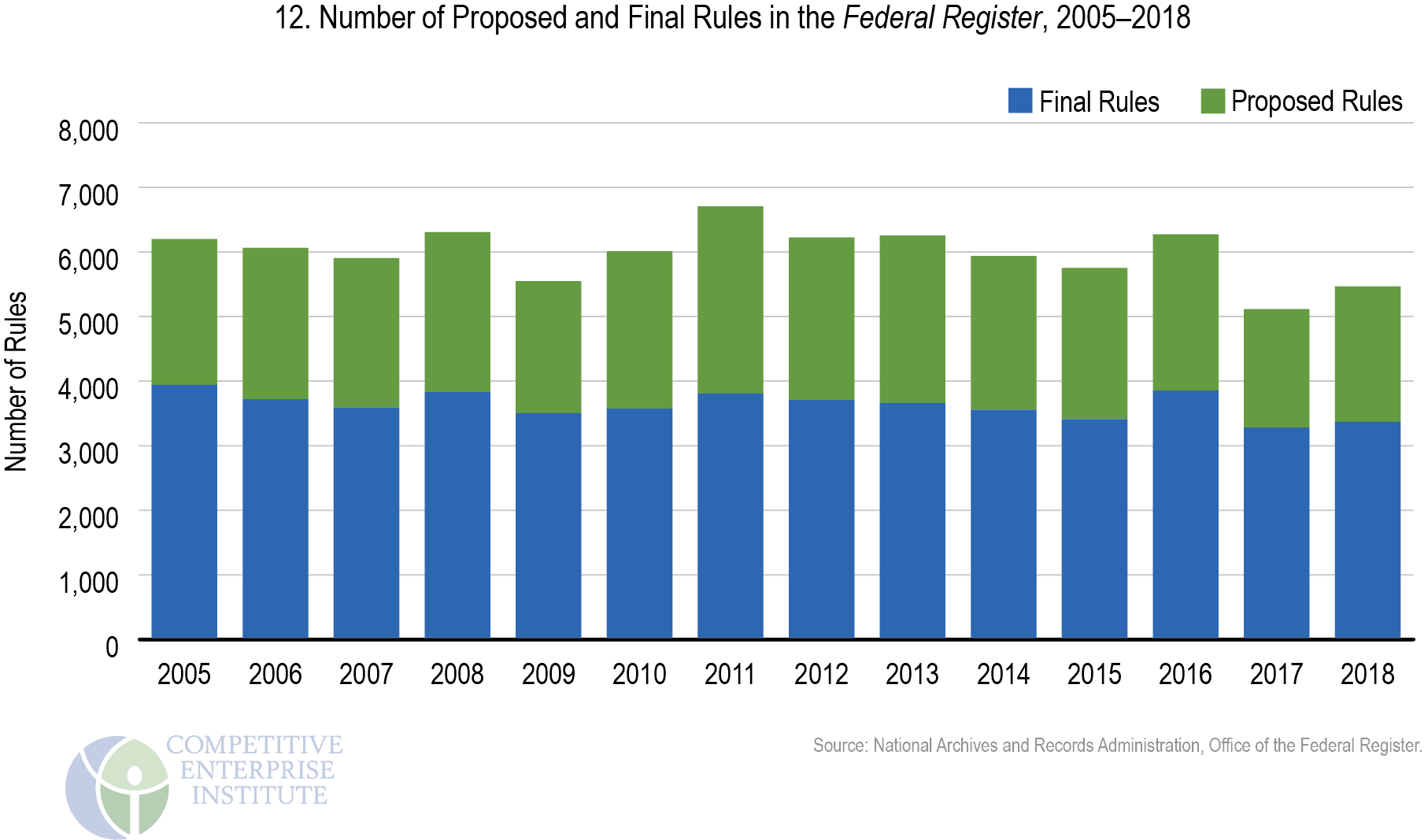
Rules deemed “significant”—a broader assortment than the “economically significant” rules—are worth focusing on.[i] Among Obama’s 3,853 final rules in 2016, 486 were deemed “significant” under Executive Order 12966, the highest count over the past two decades. While several hundred “significant” final rules are the norm, the Trump administration issued 199 and 108 in 2017 and 2018, respectively, the lowest since 164 in 2006 and 180 in 2007.[ii] (However, figures in the National Archives online database have not remained consistent in tabulations of significant rules.)
As the Trump era has demonstrated, stopping or slowing rules in the pipeline is easier than getting rid of existing rules. On an ongoing basis, more detailed official proposed rule analysis would be worthwhile. For example, it would be helpful for the Federal Register to clearly flag which among proposed rules are deregulatory as opposed to regulatory. That would allow better analysis of the routine and significant among forthcoming rules. In any event, in Obama’s final year of 2016, 2,419 proposed rules appeared in the Federal Register. In Trump’s first year, these fell to 1,834 (counting the 156 that had been issued by Obama during the first three weeks of 2017) and stand at 2,098 in his second year. Back in the 1990s, far greater numbers of proposed rules being present in the annual pipeline were typical. (For the numbers of proposed and final rules and other documents issued in the Federal Register since 1976, see Appendix: Historical Tables, Part B.)
Cumulative Final Rules in the Federal Register
The annual outflow of over 3,000 final rules—and often far more—has meant that 104,748 rules have been issued since 1993, when the first edition of Ten Thousand Commandments was published (see Figure 13). Going back to 1976, when the Federal Register first began itemizing them, 201,838 rules have been issued (see Historical Tables, Part B).

The Expanding Code of Federal Regulations
The page count for final general and permanent rules as they come to rest in the Code of Federal Regulations (CFR) is more modest than that of the Federal Register, but still considerable. In 1960, the CFR contained 22,877 pages. Since 1975, its total page count has grown from 71,224 to 85,434 at the end of 2018, including the index—a 160 percent increase. The number of CFR bound volumes stands at 242, compared with 133 in 1975. (See Figure 14. For the detailed breakdown numbers of pages and volumes in the CFR since 1975, see Appendix: Historical Tables, Part C.) In recent years, traditional rules and regulations have been supplemented by various forms of executive actions and regulatory guidance documents, which are important to track as well.
